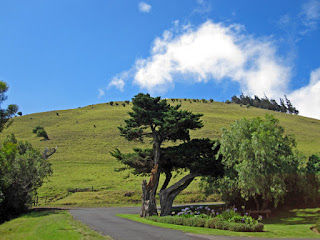In 1897, the Oʻahu Sugar Company established a large-scale sugar plantation on the dry, southwestern side of Oʻahu. Irrigation water for the sugar-cane plantation was initially pumped from the Pearl Harbor aquifer.
Because of the high pumping cost, the Oahu Sugar Company constructed the Waiāhole Ditch System to transport, by gravity, surface water from the northeastern side of the Koʻolau Range. The Waiāhole Ditch collection and delivery system was initially constructed during 1913-1916.
The system intercepts large amounts of dike-impounded ground water at high altitudes (above approximately 700 to 800-ft) that previously discharged to Waiāhole (and its tributaries Waianu and Uwao), Waikāne and Kahana Streams through seeps and springs.
The main tunnel through the Koʻolau Range was primarily designed as a transmission tunnel. The success of this tunnel in intercepting large amounts of dike-impounded ground water in the Koʻolau Range led to the construction of additional high-level ground-water development tunnels.
Between 1925 and 1935, six tunnels with headings directed into the Koʻolau Range were added to the ditch system to develop ground water stored in dike compartments. Four development tunnels (Uwao, Waikāne 1, Waikāne 2 and Kahana) were considered successful.
For nearly a century, the Waiāhole Ditch System has diverted an average of approximately 27-million gallons per day of water from the wet, northeastern part of windward Oʻahu, to the dry, central part of the island to meet irrigation needs.
This diverted flow consists of ground water gained from the connecting tunnels, the four development tunnels, and the trans-Koʻolau tunnel and of surface water gained primarily from Kahana Valley.
The flow diversion through the tunnel is pretty low tech; a redwood board determines the flow direction and amount. Depending on which marker the board is raised or lowered to, more or less water flows to leeward or windward areas.
If the board is raised, more water flows to the leeward side. Conversely, the more the board is lowered, the greater the amount of water that flows to Waiāhole stream.
The Waiāhole Ditch collection and delivery system is a 26.5-mile-long system, also called "the ditch," extending from Kahana Valley on the Windward side to the Kunia area on the Leeward side.
The effects of Waiāhole Ditch diversions received significant attention in 1993, when it became known that large amounts of diverted water were not being used for irrigation and instead were being released into streams on the leeward side of Oʻahu. This coincided with the Oʻahu Sugar Company announcement of the closure of its sugar-plantation operations.
Windward stream water for leeward uses initiated a legal proceeding (Waiāhole Ditch Contested Case) before the Hawaiʻi Commission on Water Resource Management (CWRM) over rights to the water.
The Waiāhole case arose from the efforts of small family farmers and Native Hawaiians, led by citizen groups Hakipuʻu ʻOhana, Ka Lahui Hawaiʻi, Kahaluʻu Neighborhood Board, Makawai Stream Restoration Alliance and a coalition of supporters (collectively the "Windward Parties"), to restore streams originally diverted by Central O`ahu sugar plantations.
But large scale agricultural and development interests, including Campbell Estate, Robinson Estate, Kamehameha Schools, Dole/Castle & Cooke, and others, joined by the State, pushed to continue the flow of Windward water to leeward lands to subsidize golf course irrigation, short-term corporate agriculture, and housing development.
After seven months of administrative hearings, the Water Commission issued its first decision in 1997, which both the Windward and Leeward parties appealed to the Hawaiʻi Supreme Court.
The Windward Parties argued that not enough water had been restored to the streams, while Leeward interests complained that too much water had been returned.
In August 2000, the Hawaiʻi Supreme Court issued a landmark decision in the first appeal. Although the Court acknowledged the Commission's efforts at stream restoration, it vacated the Commission's decision and sent the case back to the Commission.
After holding more hearings, the Commission issued a second decision in December 2001, which the Windward Parties again appealed.
The Court ruled that much of the decision failed to comply with the State Water Code and public trust principles, and the Commission had failed to make sufficient findings, based on evidence in the record, to support its various rulings.
It ordered the Commission to reconsider the amount of water the Windward streams need to support native stream life and community uses, vacated permits the Commission had issued to Leeward interests, and ordered the Commission to make a new decision on the permits that followed from the evidence.
On July 14, 2006, the Hawaiʻi State Commission on Water Resource Management issued a split decision in the landmark water rights litigation over the stream flows diverted by the Waiāhole Ditch System on O`ahu.
Four members of the Commission (a majority) voted to largely maintain the allocations the Commission approved in its original 1997 decision, including extensive diversions for Leeward uses, such as corporate agriculture and golf courses.
However, two Commissioners issued a dissent criticizing the majority for failing to give more protection to Windward stream resources and uses. As Water Commission Chair, I was happy to have authored the dissent (with significant assistance from the Attorney General’s office) and pleased that Chiyome Fukino, state Department of Health Director, joined me in the dissent.
In 2010, the Intermediate Court of appeals vacated the water use permit issued in the 2006 decision and remanded the case back to the Water Commission.
(Lots of information here from USGS and EarthJustice reporting on the ditch system and Waiāhole Ditch case.) The image shows the drilling of the tunnels for the Waiāhole Ditch; in addition, other images have been added in a folder of like name in the Photos section on my Facebook and Google+ pages.
Follow Peter T Young on Facebook
Follow Peter T Young on Google+
© 2013 Hoʻokuleana LLC







.jpg)


-Adverbs-Prepositions.jpg)



.jpg)